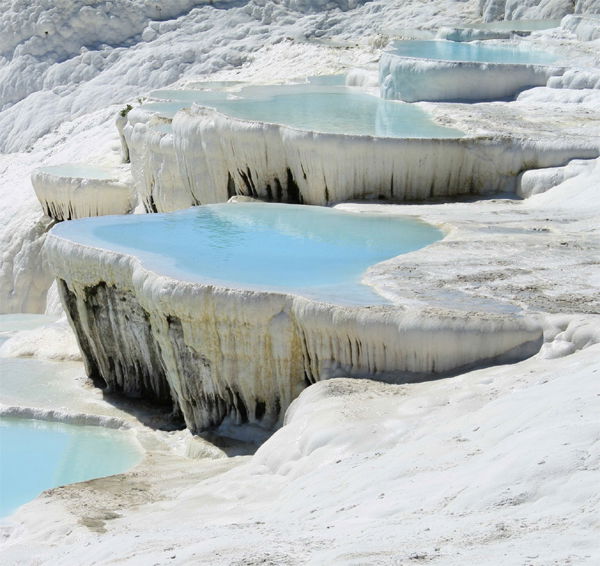Cotton Castle
Pamukkale, Turkey
Every year “Cotton Castle” in Turkey attracts a million visitors who are eager to see its spectacular stepped terraces and “frozen” waterfalls or to find refreshment in its oyster-shaped mineral pools. Today the region is called Pamukkale (Turkish for “cotton castle”). But in New Testament times it was part of the thriving city of Hierapolis, famed for the healing qualities of its hot mineral springs. (In Revelation 3:15–16 Christ condemned the church at Laodicea for not being “hot” like the healing waters flowing down from nearby Hierapolis.)

badahos | Thinkstockphotos.com
These beautiful white pools in Turkey are not manmade but natural projects of mineral-rich water flowing down from hot springs. High rains and residual heat after the Flood allowed the white stone to form more rapidly than today. View larger image.
This elaborate “white castle” sprawls more than a mile (8,860 feet, 2,700 m) across the hillside. Its blazing white stones really do look like a magical castle floating in the clouds. Evolutionary geologists say it formed slowly over tens of thousands of years, as chemicals in the water precipitated out.
How Did It Really Happen?
Pamukkale’s white terraces are made of travertine, a form of calcium carbonate commonly used as a decorative stone in buildings and homes. This travertine is deposited by mineral-rich water from hot springs. (Calcium carbonate is also the main component of eggshells, seashells, and the lime in fertilizer.) Seventeen hot-water springs are just upstream of the terraces. The water temperatures range from slightly warm (95°F, 35°C) to boiling (212°F, 100°C). Gushing from the springs, this hot water is full of dissolved calcium carbonate. It flows to the head of the terraces, which appear on a sloping cliff. There it starts depositing the calcium carbonate as it cascades into each terrace level, even leaving behind a few “frozen” waterfalls.
Underground volcanic activity generates the heat in the hot springs. The volcanic waters dissolve calcium carbonate as they pass through limestones. When the water reaches the surface, it is supersaturated with calcium carbonate. As the water then flows downstream, carbon dioxide escapes from it. The water deposits the calcium carbonate as a soft jelly, which eventually hardens into travertine.
Travertine terraces appear in other active geothermal regions.
Many factors influence the rate of this reaction, including weather conditions, surrounding temperature, and the flow duration. The production of jelly continues until the carbon dioxide in the water is the same as the carbon dioxide in the atmosphere.
It has been calculated that about 25 gallons of water is needed to produce 1 pound of travertine. At today’s flow rate, over two tons of travertine are deposited daily. Spread evenly over the terraces, that means about one tenth of an inch (3 mm) of travertine is added each day.
As the earth recovered from the Flood, the flow of heat and water would have been much greater in the early years. Such conditions would have increased the rate of deposit dramatically, generating terraces more rapidly than today.
The terraces at Pamukkale are rare but not unique. Mammoth Hot Springs in Yellowstone has produced similar white travertine terraces. New Zealand was also famous for its spectacular Pink and White Terraces, located in the famed Rotorua area of North Island, until they were destroyed by a volcanic eruption in 1886. This loss is a sober reminder that these delicate beauties require a rare combination of conditions—they were made possible by conditions in the early years after the Flood but are threatened by our still-changing earth. These are very recent features, not the product of steady geologic forces working slowly over long ages.
Answers Magazine
July – September 2014
The summer issue looks at some of the earth’s most amazing rock features and explains how they formed quickly in the past few thousands of years.
Browse IssueRecommended Resources

Answers in Genesis is an apologetics ministry, dedicated to helping Christians defend their faith and proclaim the good news of Jesus Christ.
- Customer Service 800.778.3390
- Available Monday–Friday | 9 AM–5 PM ET
- © 2025 Answers in Genesis





